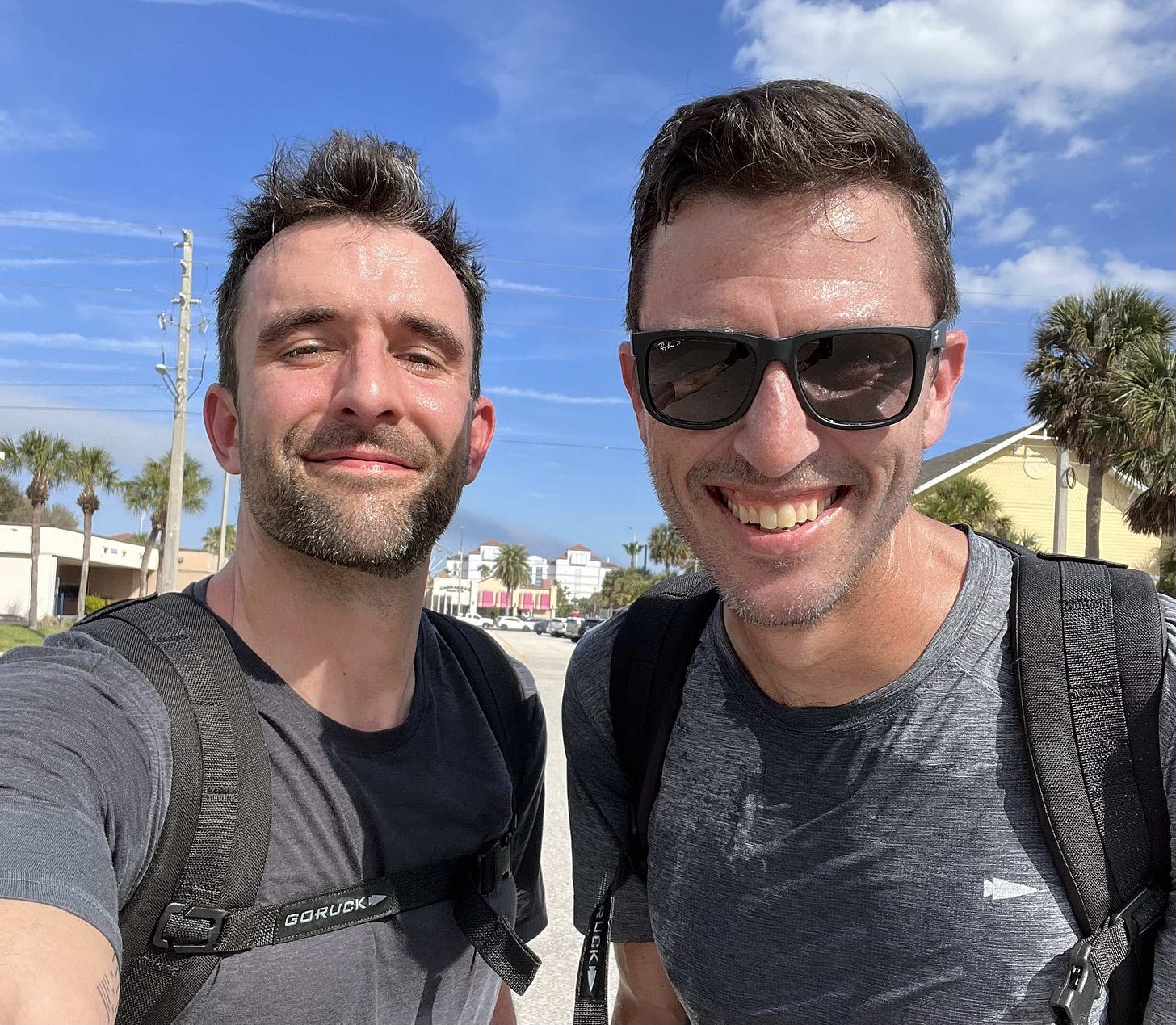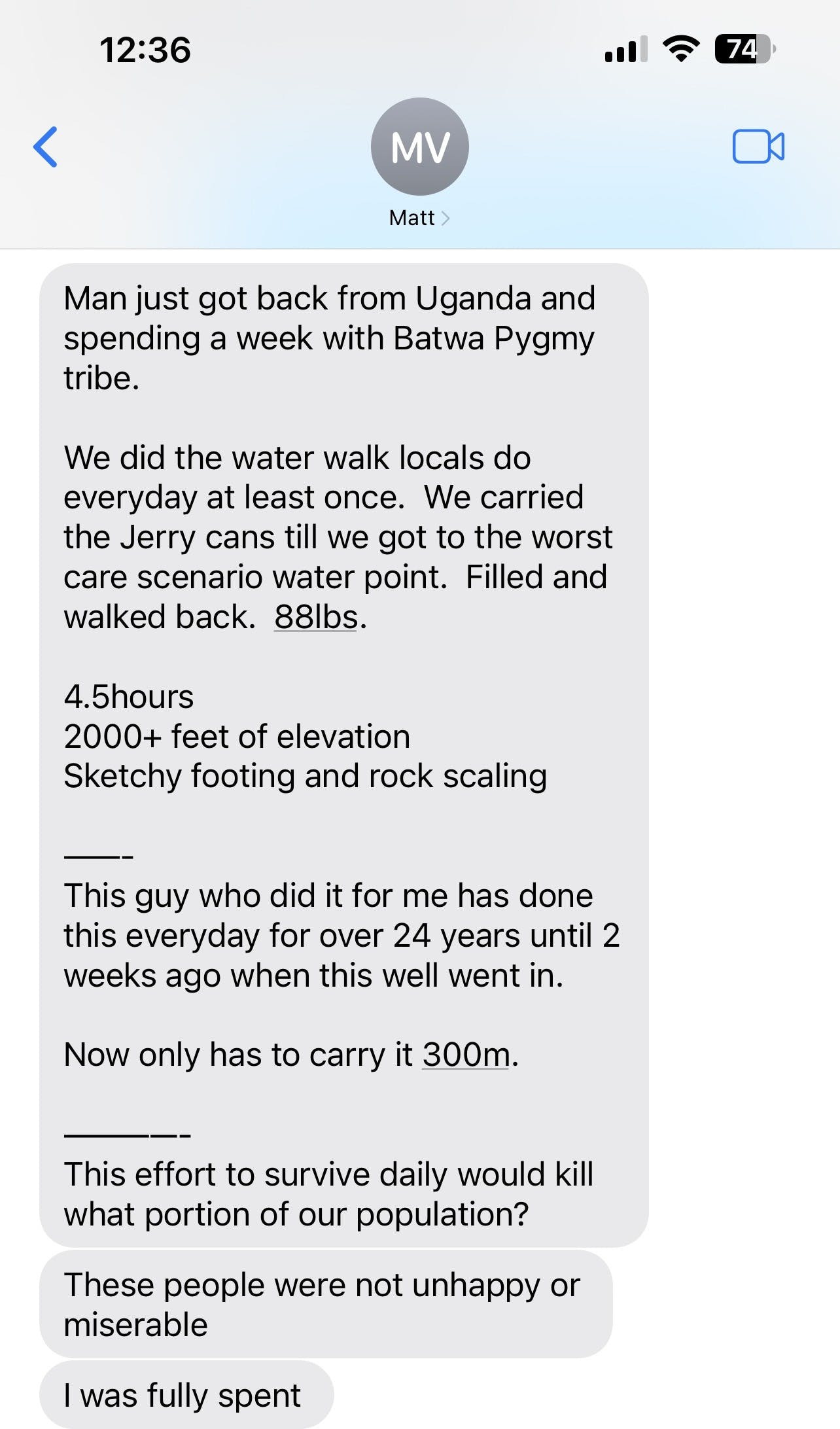I spent last Friday at GORUCK Headquarters in Jacksonville Beach, Florida.
I was there to visit friends and see new products the company is working on. Their Ballistic Trainers are now my go-to workout shoes, and they’re now developing what seems to be a great new running shoe. An emergency kit that will help me not break Rule 2 (don’t die) is also dropping soon—and much more.
After I’d chatted with everyone, Jason McCarthy had an idea. Jason is the founder of GORUCK, and you’ll recognize his name if you read The Comfort Crisis.
“We’re going to burn the ships,” he said. “There’s your ruck.”
A Rucker 4.0 pack with 100 pounds worth of ruck plates and sandbags laid on the floor.
I then found myself standing outside HQ in the Florida sun with said 100-pound ruck on my back.
The 100-Pound One-Mile Challenge
In the fall of 2022, a mild hurricane hit Jacksonville. Only Jason and a couple of other GORUCK employees were at GORUCK HQ. Strange situations can sometimes incite strange ideas—a cheap thrills, good times kind of deal.
“We decided we wanted to do something really hard before the worst of the storm hit,” Jason told me. “So we invented the 100-Pound One-Mile Challenge.”
The challenge is straightforward: Load a ruck with 100 pounds and cover one mile as quickly as possible. Simple, sinister.
Covering a mile equated to four laps around the block. Jason and I started a timer and began our laps.
A Case for Burning the Ships
In work, exercise, relationships, and more, we often do "just enough." And that's sometimes how it should be because "just enough" is sustainable.
But there are times—and my visit to HQ was apparently one of them—when it can be wise to really push your edge.
We call it “burning the ships,” nodding to the famous story from the 16th Century when Hernán Cortés burned his own ships so that he and his soldiers couldn’t turn back. For us, it meant we were going all in and finishing this challenge no matter what.
Occasionally doing something vastly more challenging than you’re used to can be a great teacher. It can show you something about your physical and mental edges. You can’t see where an edge is from afar. You need to get close to it. And in getting close, that edge can expand, changing what you can do from then on. Burning the ships can be a great reminder that we’re capable of more than we think and can alter our future abilities, perspectives, and resilience. From then on, "just enough" is more.
And this isn’t psychobabble. Research shows many of our limits are largely regulated by our thoughts and emotions. The Central Governor Theory, for example, suggests that our brain uses “the unpleasant but illusory sensations of fatigue” to convince us to stop or slow down physical effort before we’re close to true exhaustion. Our brain tells us our tank is empty when it’s still half full.
I can cite studies about the psychological tricks our brains play all day. But you won’t understand the nature of that governor—and how you can ignore it and, in turn, perform better—unless you occasionally put yourself in a position to watch the governor kick in and push on no matter.
By the final lap, I was negotiating with my own governor. Everything felt acidy, and I started thinking about how I was almost done—so why not slow down to feel a bit better? But I kept going.
Jason and I burned our fitness ships. But we can also burn the ships other areas where we’d like to grow: business, relationships, and more.
We shouldn’t burn the ships too often. We should only do tough challenges like this once every few months, or else we can get hurt or burned out. Most research suggests that it’s not the rare max-effort challenge that hurts people—it’s max-effort challenges repeated too closely together.
It’s also worth burning the ship with friends. Tough times, even if they’re manufactured, build tighter bonds. This is something the 14th Century scholar Ibn Khaldun noticed. He saw that harsh conditions require and develop social cohesion. Case in point: Look at these two idiots in the photo below, grinning despite just having self-imposed physical hell upon themselves.
Should You Take on the 100-Pound One-Mile Challenge?
That depends on your size and fitness level. If you weigh more than 150 pounds, are fit, and have no pre-existing injuries you might learn something from this test.
If you’re under 150 pounds, fit, and injury-free, maybe 70ish pounds is a better weight for you. If you’re a brick of a human (220+ pounds) and super fit, you might want to go even heavier, like 120 pounds.
If you don’t feel as fit or have a pre-existing injury or condition, you can adapt this challenge. Go much lighter, or don’t do it until you feel fitter.
The details of how you challenge yourself aren’t as important as the fact that you challenged yourself, watched your governor kick in, ignored it, and learned something from the experience.
I should note here that in The Comfort Crisis, I write at length that it’s best not to ruck with more than 50 pounds or a third of your body weight. That’s true. I weigh 180 pounds, and my “regular” rucking weight is 35 pounds. The 100-Pound One-Mile Challenge is something different—a rare test.
Tips for Heavy Rucking
I define “heavy rucking” as any weight over a third of your body weight. To figure out your heavy weight, take your body weight and multiply it by 0.333.
Going above your “heavy” changes the game, and you must adapt to that game. A few tips:
Pack your ruck so the weight doesn’t wobble around, Jason told me. That’s legit wisdom from his time in Special Forces, where soldiers must often ruck with soul-crushing loads. The reason: If you have 100 pounds shifting side to side, it’ll rip you side-to-side like a pendulum, slowing you down while increasing your risk of injury.
Don’t lock out your knees. Lean slightly forward in a mild crouch as you move. Your strides should be short so you land with a slightly bent knee. Try to have your feet strike the ground at your midfoot or just barely at the heel to ensure this.
Adapt as you go. Jason doesn’t use a hip belt. He also doesn’t swing his arms as he goes. I used a hip belt and swung my arms. Figure out what works for you. It’s going to suck no matter what you do. Cover the distance in a way that feels less sucky.
Jason says a good time for the challenge is finishing in under 12 minutes.
2% Top Two
My two favorite things this week ...
One: A Quick Survey
I’m planning bigger things for the 2% Newsletter and 2% ecosystem. I want your help shaping its future and would love to hear what would best help you.
Two: A Good Text
My friend Matt Vincent, a two-time Highland Games World Champion, recently got his butt kicked living everyday life in Uganda. He followed up the below text with "What a blessing it is I get to pick discomfort." Amen.
Thanks for reading and I'll see you next week,
Michael
Sponsored by GORUCK
When I decided to accept sponsorships for this newsletter, GORUCK was a natural fit. Not only is the company's story included in The Comfort Crisis, but I've been using GORUCK's gear since the brand was founded. Seriously. They've been around ~12 years and I still regularly use a pack of theirs that is 11 years old. Their gear is made in the USA by former Special Forces soldiers. They make my favorite rucking setup: A Rucker and Ruck Plate.







I sent this to two friends of mine who both immediately agreed to do this challenge with me. Sandbag en route and date set. In true 'burn the ships' fashion we'll be dropped off 1 mile away from the finish and recording the whole thing so giving up isn't an option. LFG!
So at 12 mins or under for a mile we are running w a 100 pounds?